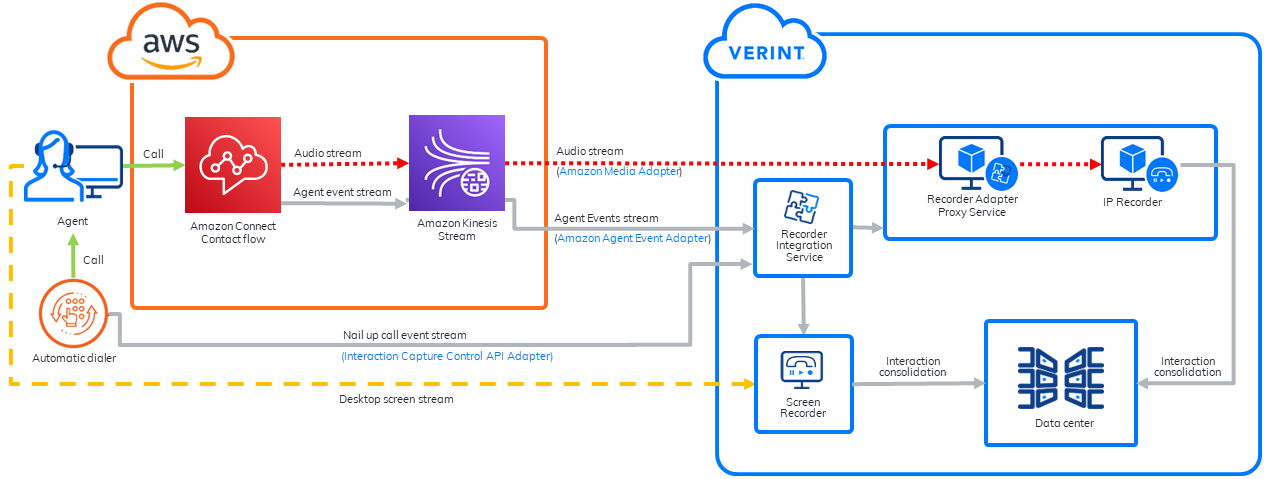Dialer integration overview
Understand the components that you need to configure when integrating Verint Recorders, an Amazon Connect contact center, and an automatic dialer application.
Components can be on-prem or in the cloud
The dialer application must be compatible with Amazon Connect.
The dialer must have access to the port used by the Interaction Capture Control API Adapter.
Verint components can be deployed on premise, in the cloud, or a combination of both.
Any private or public cloud is supported; including Verint Cloud Services (VCS), Amazon Web Service (AWS), and Microsoft Azure.
Public cloud deployments typically serve multiple tenants. Each tenant has a unique instance of Amazon Connect. In the Verint system, each tenant must have a unique set of data sources and adapters.
Different authentication for cloud and on-prem
When the Verint server roles are in the cloud, the associated adapters must authenticate using IAM roles. For server roles on premise, the associated adapters must authenticate using Application Access Keys.
Components and data flow
The following diagram depicts the interaction of components in each system when Verint records customer interactions initiated by an automatic dialer in Amazon Connect.
Only the components you need to configure for this integration are shown.

-
Amazon Connect: A PBX contact center available in the Amazon Web Services (AWS) cloud. Each tenant has a unique instance of Amazon Connect. The instance is configured to send call event data and audio streams to the Verint IP Recorder in real time.
-
Automatic dialer: A third-party application that is integrated in an instance of Amazon Connect. The dialer application must be compatible with Amazon Connect. It can be on premises (workstation or server) or on cloud (private or public). The dialer connects to the Verint Recorder Integration Service over the Interaction Capture Control API Adapter.
-
Amazon Kinesis data stream: Real-time data streaming service provided by AWS. It streams audio to the Recorder Adapter Proxy Service (RAPS). The connection between Kinesis and RAPS is made through the Verint Amazon Media adapter.
-
Recorder Integration Service (RIS): A Verint server role that receives system state, call events, and agent events from Amazon Connect and the dialer. It receives call events from Amazon Connect over the Amazon Media Adapter, and Dialer events over the Interaction Capture Control API Adapter. Based on the event, the RIS sends a start or stop recording command to the Recorder Adapter Proxy Service (RAPS). If Verint is configured to capture screen activity, the RIS sends commands to the Screen Recorder to start and stop recording. The Amazon Media Adapter uses the call events from Amazon Connect to identify the portions of the nail up call that are customer interactions.
-
Recorder Adapter Proxy Service (RAPS): A Verint server role that forwards the audio stream from Amazon Kinesis to the IP Recorder. It forwards recording commands from the Recorder Integration Service (RIS) to the IP Recorder. The RAPS is always collocated with the IP server. In deployments that handle thousands of calls per hour the RIS and RAPS are deployed on separate servers.
-
IP Recorder: A Verint server role that captures the call audio received from the Amazon Media adapter on the RAPS role. The IP Recorder starts, pauses, and stops recording based on the event data it received from the RAPS. An IP Recorder is collocated with a Recorder Adapter Proxy Service (RAPS).
-
Screen Recorder: A Verint server role that captures an agent's screen activity during a customer interaction. It receives events and screen changes from the Screen Capture module installed on the agent's desktop computer. It forwards captured events and screens to the Recorder Integration Service (RIS).
-
Data Center: A Verint server role that archives and correlates event data with captured interactions.
-
Enable High-Volume Outbound Communications, Amazon Connect Administrator Guide